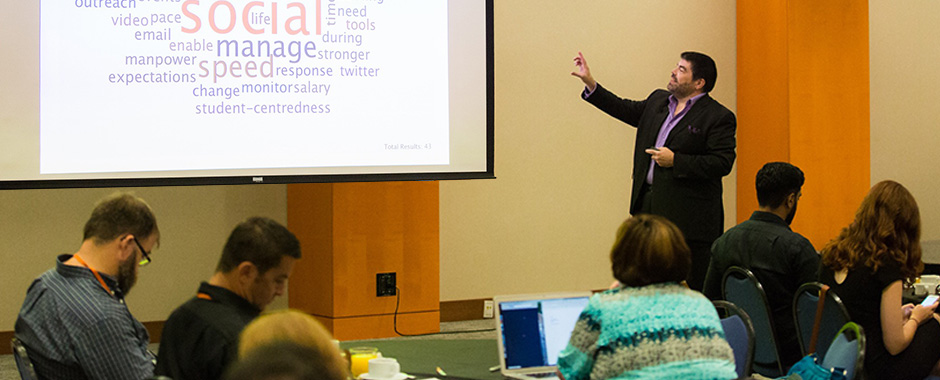AV & IT Requirements
Whether live or virtual, Ken normally leverages multiple layers of video, animation, sound effects and music for his presentations, along with real-time online polling. For the best experience, we want everything to flow smoothly — so please ensure that the front-line A/V technicians at the venue have had a chance to see this page well in advance of the event itself!
Ken’s MacBook near the Stage
Configuring the real-time polling and Apple Keynote software, and transferring gigabytes of video and slides, means it just isn’t practical to use the venue’s computers or present from a USB stick. Please ensure that Ken can run his presentation from his own laptop, and preferably from a position near the stage or podium so that he can make adjustments to polling results on the fly as necessary, or skip sections of the presentation in order to stay on time.
Projection
Depending on the size of audience, we’ll want at least one large video monitor or projection screen. We want participants to get the maximum impact from visuals, video clips, graphs and slides so please ensure we have adequate brightness on the projector, and as much as possible mask off light sources that could wash out the screen (pot lights, spot lights, windows and skylights). Ken’s slide decks are formatted 4:3, so if possible the projector should be optimized for that size.
HDMI Connection
Ken’s MacBook has native HDMI and VGA ports to connect the projector(s) or screen(s). Please note that, even with strong broadband wifi, every time we’ve tried to use wireless connections to monitors or projectors (even Apple’s own AirPlay) the results have been pretty disappointing, because full-motion video stutters and jumps, and often audio and video fall out of sync.
Audio Amplification
Ken’s slides use sound effects and background music throughout, and video clips with interviews or demonstrations. We will always need some form of amplification for the laptop audio, either through a sound mixing board or simply a pair of large desktop speakers. Ken’s MacBook uses a standard 3.5mm mini-headphone jack for audio output. (HDMI for audio is an option, but not preferable.)
Microphone
Because Ken is often presenting for hours a day, days in a row, a wireless lapel mic will help preserve his voice and allow him to be heard without needing to shout. Obviously in a room of 20 people or fewer, a microphone is probably unnecessary, but when the audience is more than 20, and especially when a workshop approach will generate plenty of background noise, a mic is pretty much required. We’ll get the most dynamic presentation with a wireless mic that allows for maximum mobility, and Ken requests mics in the following order of preference:

1) Wireless lapel 2) Wireless over-ear 3) Wireless handheld 4) Dual-ear 5) Wired handheld (long cable) 6) Stationary podium mic
For Q&A in a large theatre, or for table reporting in a workshop with more than about 5 tables, it will likely be important to have at least one wireless handheld mic for participants to use as well.
Internet Access
Ken usually makes use of PollEverywhere to make keynotes and workshops more interactive for participants. To use this software, Ken will require wifi or wired internet access, either through a public network or using a guest ID and password for the day. The faster the connection speed, the smoother the resulting graphs will be in his presentation. The more participants in the room using the wifi, the more we may slow down a connection without high bandwidth. Participants should be encouraged to bring a smartphone, tablet, laptop or even a “dumb phone” with SMS texting capability.

Distance Delivery
If you are planning a virtual keynote or presentation, please see the technical requirements here.
Video Recording
Some campuses choose to video record or simulcast Ken’s presentations, and this is permitted so long as video and/or slides are not posted publicly on the web, and a copy of event video is provided to Eduvation on DVD or as a downloadable link. Because Ken will be using his own MacBook to present, you will need a video splitter in order to capture slide output in real time. If you want to use memory-resident software to broadcast the slides to a remote location, we will need to test that software in advance to ensure it does not conflict with the other tools Ken uses.
Slides Afterwards
Ken will provide a PDF of his slides after the event, which can be distributed to participants or others within your institution, but must not be posted publicly on the web. It will incorporate the results of any real-time polling done with your group, and web URLs to source video and other materials referenced in the presentation.
Workshop Logistics
Typically more interactive sessions work best with participants seated in “half rounds” at tables of 5 to 8 people. Normally, Ken uses online tools to collect ideas and accelerate table reporting, but in some cases more traditional tools may be requested. (These might include a flip chart and stand, markers and 50-100 square 3×3″ post-it notes for each table. Typically a roll of masking tape is also essential, unless the flip charts have self-adhesive pages.) We should discuss these logistics as we develop the detailed agenda for your workshop.
If in doubt, please ask!
If you are the front-line A/V tech or IT professional responsible for setting up the room, and this page has not adequately answered your questions, please don’t hesitate to ask Ken directly at ken@eduvation.ca. We will work to improve this page based on your feedback, if it is unclear or incomplete. Thank you!
All contents copyright © 2014 Eduvation Inc. All rights reserved.
